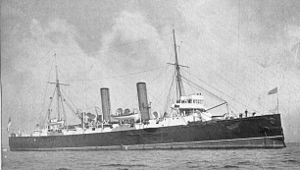HMS Hermione (1893)

| |
| History | |
|---|---|
| Name | HMS Hermione |
| Laid down | December 1891 |
| Launched | 7 November 1893 at Devonport[1] |
| Renamed | TS Warspite in 1922[2][3] |
| Fate | Broken up September 1940[2][3] |
| General characteristics | |
| Class and type | Astraea-class cruiser |
| Displacement | 4,360 tons |
| Length | 320 ft (98 m) (p/p) |
| Beam | 49.5 ft (15.1 m) |
| Draught | 21 ft 6 in (6.55 m) |
| Propulsion | Triple expansion engines Two shafts 7,500 ihp |
| Speed | 18 knots (33 km/h; 21 mph) (natural draught) 19.5 knots (36.1 km/h; 22.4 mph) (forced draught) |
| Range | Carried 1000 tons coal (max) |
| Complement | 318 |
| Armament |
|
| Armour |
|
HMS Hermione was an Astraea-class Royal Navy protected cruiser launched at Devonport in 1893. She served in World War I and was sold in 1921. She was renamed training ship Warspite in 1922, and broken up in 1940.
Hermione was a 10-gun twin-screw cruiser of 4360 tons, 9,000 horsepower (6,700 kW), and capable of 19 knots (35 km/h; 22 mph). The vessel was 320 feet (98 m) in length, had a beam of 49 feet (15 m), and a draught of 19 feet (5.8 m).
Service history[]
In 1896 Hermione, commanded by Captain Charles R. Arbuthnot, was one six ships which was specially commissioned as part of a new squadron in reply to a congratulatory telegram from the German Emperor to President Paul Kruger on the repulse of Dr. Jameson's Raid. The squadron, known as the Particular Service Squadron, was commanded by Rear-Admiral Alfred Taylor Dale with his flag in Revenge.
Hermione was assigned to the China Station in 1898. In 1900 she played a minor part in the third China war or Boxer Rebellion. In December 1899 and April 1900, Marines from Hermione served as an honour guard and pallbearers for the funerals of the Governor of the Straits Settlements, Sir Charles Mitchell[4] and the Chief Justice of the British Supreme Court for China and Corea, Sir Nicholas John Hannen, who had also served as consul-general in Shanghai.[5]
In May 1902 she was posted to the Mediterranean station.[6] Attached to the cruiser division, she visited Argostoli with other ships of the division in early October 1902.[7]
In 1906 Hermione went into reserve at Portsmouth, refitted in 1907 and sent to the Cape Town Station. On 14 February 1909 she ran aground at Zanzibar but was re-floated sustaining only slight damage. In June 1909 she joined the 3rd Cruiser Squadron at Portsmouth and in July joined the Home Fleet. On 6 August Hermione ran aground off Killingholme in the Humber and after 8 hours was re-floated.
In September 1910 she began preparations for use as a tender for the Royal Navy's first airship, but when this project was abandoned, she rejoined the Home Fleet in January 1912. In the meantime, she had hosted the first British seaplane experiments, with an Avro Type D in November 1911.
At the outbreak of World War I in August 1914, she became guard ship at Southampton, later becoming HQ Ship for motor launches and coastal motor boats from December 1916 until December 1919. Sold off October 1921 and resold to the Marine Society in 1922 and became training ship Warspite, finally scrapped September 1940.[2][3][8]
Notes[]
- ^ The Times (London), Wednesday, 8 November 1893, p.6
- ^ a b c "HMS Hermione". battleships-cruisers.co.uk. Retrieved 8 August 2015.
- ^ a b c "TS Warspite". battleships-cruisers.co.uk. Retrieved 4 June 2021.
- ^ "Sudden Death of H. E. the Governor". The Singapore Free Press and Mercantile Advertiser. 7 December 1899. p. 3.
Scroll to THE FUNERAL ARRANGEMENTS
- ^ North China Herald, 2 May 1900, p785. Hannen's granddaughter was named Hermione Hannen, presumably because of this event.
- ^ "Naval & Military intelligence". The Times. No. 36760. London. 6 May 1902. p. 11.
- ^ "Naval & Military intelligence". The Times. No. 36896. London. 11 October 1902. p. 11.
- ^ Gardiner, p. 77
References[]
- Gardiner, Robert, ed. (1979). Conway's All the World's Fighting Ships 1860–1905. Greenwich: Conway Maritime Press. ISBN 0-8317-0302-4.
- Astraea-class cruisers
- Ships built in Plymouth, Devon
- 1893 ships
- World War I cruisers of the United Kingdom